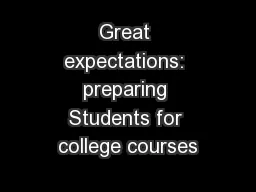

Derek Petrey derekpetreysinclairedu common expectations 5 We will set our devices phones to mute vibrate We may leave the room discreetly if we need to take care of business Our honest feedback makes this training more relevant and authentic ID: 611945
Download Presentation The PPT/PDF document "Great expectations: preparing Students f..." is the property of its rightful owner. Permission is granted to download and print the materials on this web site for personal, non-commercial use only, and to display it on your personal computer provided you do not modify the materials and that you retain all copyright notices contained in the materials. By downloading content from our website, you accept the terms of this agreement.
Slide1
Great expectations: preparing Students for college coursesDerek Petreyderek.petrey@sinclair.eduSlide2
common expectations (5)We will set our devices / phones to mute / vibrate.We may leave the room discreetly if we need to take care of business.Our honest feedback makes this training more relevant and authentic.We will “lean in” or “lean out” to allow everyone a chance to share.The moderator’s job is to enforce the common expectations. Others?Slide3
Activity: what do you cover on your first day of class? (10)Work in groups of 4 and generate a list of 8 topics you would mention or cover on your first day. Take 10 minutes to do this.Slide4
OUR RESPONSES HERE – first day (5)Slide5
CHANGE the environment (5)What will be different about the classroom from the first class meeting onward?Write the name & number of the course on the board. How will you present yourself?How will students be accessing the text / the syllabi / using technology in the class?Slide6
model expectations / Connect to resources / model behaviors (10)Have students learn each other’s names. Start to learn their names. Break down the cliques.Set and share expectationsIntroduce the course (how can you do this?)Show the textbook – use the textbook!Go to my.Sinclair.edu and the eLearn shellShow the syllabus – explain how the syllabus worksLook at course policies – create ground rules / common expectationsSlide7
EXPECTATIONS activity (10)Take 5 minutes to scan the sheet. It has two sides (front and back), so you are reading quickly. If you normally teach in a high school, cross out (put a line through) any expectation that you don’t think normally happens in your high school class. Look at the list of college expectations. Underline or circle the ones that you think will be the hardest for your students to adapt to in the college class. After you have spent the 5 minutes scanning and marking, spend 5 minutes with a partner comparing how you marked up the paper. Slide8
OUR RESPONSES – EXPECTATIONS (5)Slide9
sharing expectations – the syllabus (5)regportal.sinclair.eduThe syllabus for any course constitutes a perceived contract between instructor and student. The contract runs from the first class until the final grade is assigned. The teaching syllabus must match the Master Syllabus in these aspects:. Course Number and TitleCredit Hours (Lecture and Lab)Course DescriptionGeneral Education OutcomesCourse Outcomes: (Outcomes and Means of Assessment)Slide10
additional syllabus content (5)Instructor InformationTextbook InformationSupplementary ReadingsCourse RationaleCourse ScheduleCourse PoliciesAttendance / Participation PoliciesExams, Assignments and other AssessmentsSlide11
final syllabus considerations (5)Avoid offering explicit guarantees.Never include anything that conflicts with institutional policies. Add disclaimers to the syllabus, reserving the right to deviate from the syllabus schedule.Keep the rules fair for everyone.Slide12
mOTIVATION (10)superficial / strategic / deep learning (Ken Bain)extrinsic vs. intrinsic motivation control vs. autonomy external direction vs. self-efficacyoutside rewards or punishment (grades, money, approval) vs. topic mastery how can you measure?Slide13
additional resources937-512-HELPyour chair / course coordinatorctl.sinclair.edu937-512-3115937-512-3116please use the bottom of the evaluation form to answer this question:what additional resources would be helpful for CCP faculty?